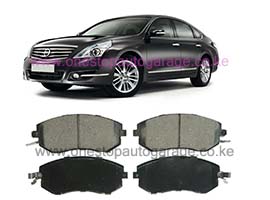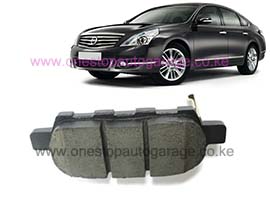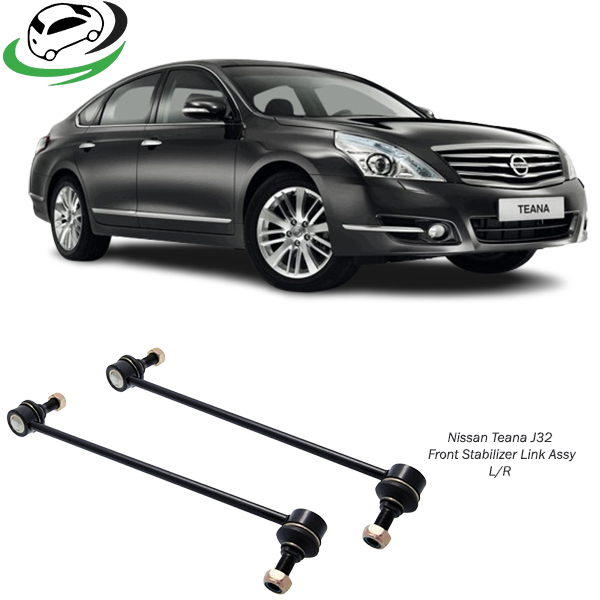-14%
Get Nissan Teana J32 Front Stabilizer Link 54668-JD00A in Kenya
The front stabilizer link is a vital component in a vehicle’s suspension system, helping to maintain stability, reduce body roll, and enhance overall handling and safety. As part of the stabilizer (or sway) bar assembly, this link serves to connect the sway bar to the suspension control arms, enabling the bar to mitigate excessive sway or lean during cornering. This in-depth overview will cover the stabilizer link’s role, structure, types, benefits, symptoms of failure, and maintenance tips.
1. Purpose and Function of a Front Stabilizer Link
The primary function of a front stabilizer link is to link the stabilizer (sway) bar to the suspension system, facilitating effective vehicle handling by reducing sway or roll. Here’s how it achieves this:
- Stabilizing During Turns: When a vehicle corners, weight shifts, causing the body to lean towards the outside of the turn. The stabilizer bar, linked to each wheel’s suspension via stabilizer links, reduces this lean by distributing force to the opposite side, making the car feel more level and stable.
- Enhancing Control and Safety: By reducing roll, the stabilizer link helps the driver maintain better control of the vehicle, especially during sharp turns or emergency maneuvers. This stability is critical for both everyday driving and more demanding driving conditions.
- Maintaining Alignment and Tire Wear: Stabilizer links assist in keeping wheels properly aligned during turns. This function not only supports tire longevity by reducing uneven wear but also improves the overall driving experience by enhancing directional stability.
2. Structure and Composition of a Stabilizer Link
The stabilizer link is typically composed of the following elements:
- Link Rod: The main body or shaft of the stabilizer link, usually crafted from steel or other durable metals to withstand significant stress. This rod bridges the gap between the stabilizer bar and the control arm.
- Ball Joints or Bushings: Stabilizer links use either ball joints or bushings at each end to provide the necessary flexibility and rotation. Ball joints, commonly used in modern stabilizer links, allow a wider range of motion and reduce friction.
- Bushings: In some designs, rubber or polyurethane bushings may replace ball joints. Bushings reduce noise and provide cushioning but may wear down faster than ball joints in high-stress applications.
- Protective Coatings: To resist rust and corrosion, stabilizer links are often coated or treated. This coating enhances their durability, particularly in harsh climates or under heavy usage.
3. Types of Front Stabilizer Links
There are different types of stabilizer links based on design and application:
a) Standard Stabilizer Links
Standard stabilizer links consist of a simple metal rod with bushings or ball joints at both ends. They’re typically found in standard passenger vehicles and are sufficient for regular driving conditions.
b) Heavy-Duty Stabilizer Links
Heavy-duty stabilizer links are reinforced to handle greater loads and stresses, making them ideal for off-road or heavy-duty vehicles. These links often have thicker rods and more durable bushings or ball joints, increasing their resilience.
c) Adjustable Stabilizer Links
Adjustable stabilizer links allow for custom alignment and can be fine-tuned based on the driver’s preference or specific driving needs. They are often found in performance or modified vehicles, where handling adjustments can be beneficial.
4. Benefits of Using High-Quality Stabilizer Links
Investing in quality stabilizer links provides multiple benefits:
- Improved Handling and Stability: Stabilizer links play a direct role in enhancing cornering and stability, allowing for smoother, more controlled turns, which is essential in both normal and high-speed driving situations.
- Enhanced Ride Comfort: By reducing body roll, stabilizer links help maintain a more comfortable and level ride, especially for passengers. This comfort becomes particularly noticeable on winding roads or during sudden turns.
- Better Tire and Suspension Longevity: Well-functioning stabilizer links reduce excess pressure on other suspension components, contributing to more even tire wear and extending the life of suspension parts.
- Increased Safety: Stabilizer links support a safer driving experience by helping the vehicle remain balanced and responsive. This is particularly important in emergency situations where stability is crucial.
5. Signs and Symptoms of a Failing Front Stabilizer Link
Like any suspension component, stabilizer links can wear out over time. Recognizing early warning signs of failure can help prevent further issues and maintain vehicle safety.
a) Clunking or Knocking Noises
A common symptom of a worn stabilizer link is a clunking or knocking sound, especially when driving over bumps or turning. The noise occurs due to the excessive play in the link, often caused by worn-out ball joints or bushings.
b) Excessive Body Roll
If the stabilizer link is damaged, the stabilizer bar can’t perform optimally, leading to excessive body roll during cornering. This issue makes the vehicle feel less stable and is particularly noticeable when making sharp or fast turns.
c) Poor Handling and Steering Responsiveness
A failing stabilizer link can impact handling and reduce steering response. This change can make the vehicle feel loose or difficult to control, particularly during high-speed driving.
d) Uneven Tire Wear
When stabilizer links wear out, they may cause misalignment, which leads to uneven tire wear. If you notice abnormal tire wear, it could be a sign of a suspension or alignment issue, including possible stabilizer link wear.
6. Maintenance and Replacement of Stabilizer Links
Maintaining stabilizer links is essential for preserving handling performance and overall vehicle safety.
a) Regular Inspections
Routine inspections are recommended to check for worn-out or damaged links. Mechanics often look for signs of play or looseness in the link as well as any visible wear in the bushings or ball joints.
b) Timely Replacement
Stabilizer links are not typically serviceable, so if they are damaged or worn out, they need to be replaced entirely. Replacing stabilizer links when needed can prevent further damage to the suspension system.
c) Using High-Quality Parts
High-quality stabilizer links are designed to withstand tough conditions and last longer. Opting for OEM (Original Equipment Manufacturer) or trusted aftermarket brands can ensure compatibility and durability.
d) Avoiding Harsh Driving Conditions
While stabilizer links are built to handle rough roads, excessive stress from extreme driving conditions can lead to quicker wear. Avoiding aggressive driving and heavy loads can help extend their lifespan.
7. Replacement Process of Front Stabilizer Links
Replacing front stabilizer links requires some basic tools and mechanical knowledge. However, if you are not experienced, it’s best to leave this task to a professional mechanic. Below is a step-by-step guide to the replacement process:
a) Tools Needed
- Jack and jack stands
- Socket set and wrenches
- Penetrating oil (if needed for rusted bolts)
- Torque wrench
b) Replacement Steps
- Lift the Vehicle: Use a jack to lift the vehicle and secure it with jack stands. Ensure the vehicle is stable and the wheels are off the ground.
- Remove the Wheel: Take off the wheel to access the stabilizer link.
- Detach the Old Stabilizer Link: Use a wrench to remove the bolts or nuts securing the stabilizer link to the control arm and the sway bar. Penetrating oil may help loosen any rusted bolts.
- Install the New Stabilizer Link: Position the new stabilizer link in place, aligning it with the sway bar and control arm. Attach it securely using bolts or nuts, torquing to the manufacturer’s specifications.
- Reinstall the Wheel: Place the wheel back on and tighten the lug nuts.
- Lower the Vehicle and Test Drive: Once everything is secure, lower the vehicle and take it for a test drive to ensure proper handling and stability.
8. Importance of Quality and Regular Maintenance
A well-maintained front stabilizer link is essential for the performance and safety of your vehicle. Regular maintenance, such as routine inspections, can help detect wear early and ensure a timely replacement. Investing in quality stabilizer links contributes to a safer, more comfortable ride and can save on repair costs by preventing excessive wear on other suspension components.
9. Conclusion
The front stabilizer link is a critical part of a vehicle’s suspension system, connecting the sway bar to the suspension arms and contributing significantly to stability, handling, and passenger comfort. By reducing body roll and aiding in vehicle control during cornering, it provides an added layer of safety and handling precision. Recognizing the signs of a failing stabilizer link, conducting regular inspections, and replacing worn components promptly are essential practices to keep your vehicle safe and responsive on the road.
Follow us on Facebook for more parts.



